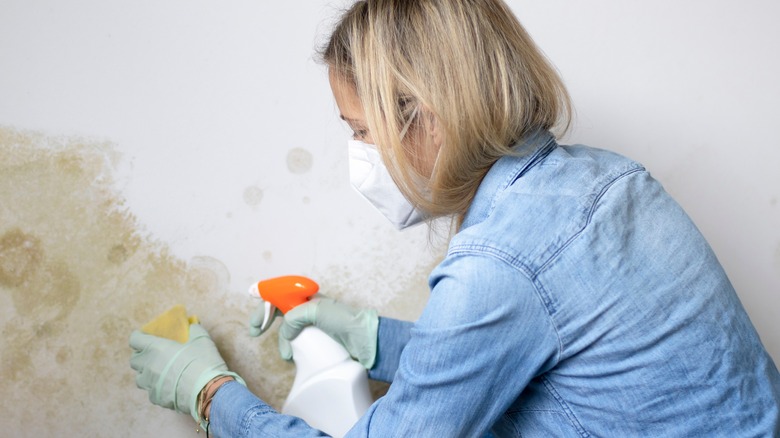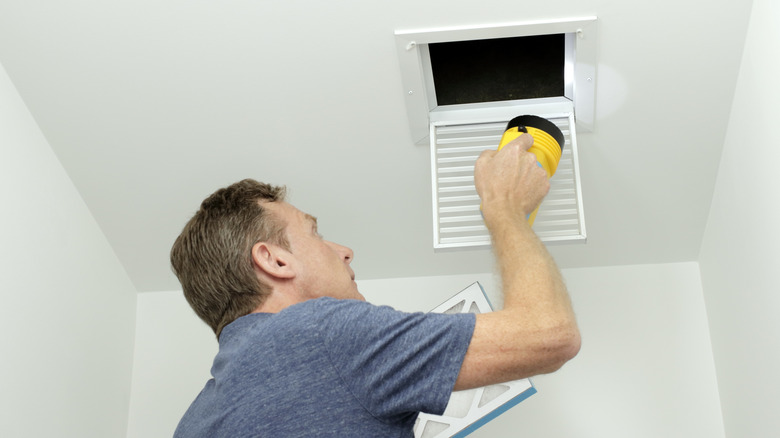How To Know If You're Allergic To Mold
Nobody wants to deal with a mold problem in their home. Not only can it be costly to remove, but continuous exposure to mold spores may pose certain health risks, particularly for people with compromised immunity or specific health conditions, according to the Centers for Disease Control and Prevention (CDC).
It's easy to panic at the thought of a mold infestation. For many of us, our imaginations may conjure up frightening images of Stachybotrys chartarum — or what most people refer to as black mold. However, there are many misconceptions surrounding this type of mold. While Stachybotrys chartarum does give off mycotoxins, the risks of poisoning are primarily associated with ingesting large amounts of these toxins, rather than through inhalation (via Healthline).
Additionally, some people believe that black mold poses a unique risk to young infants in the form of acute idiopathic pulmonary hemorrhage, or bleeding in the airway (via CDC). However, no research has definitively determined a direct link between the condition and Stachybotrys chartarum mold exposure, the CDC notes.
What is known, however, is that for some people, mold exposure can trigger an allergic reaction. Here's how to tell if you might be dealing with a mold allergy.
Note your symptoms and consult an allergist
While some molds are classified as non-toxic, they can still provoke allergy-like symptoms (via All Dry Us). Such symptoms of a mold allergy include sneezing, coughing, congestion, wheezing, throat irritation, and more. In some cases, those with a mold allergy may also experience hives or a rash. Individuals with pre-existing respiratory conditions such as asthma may experience more severe symptoms, while those with compromised immunity or lung disease may stand at an increased risk for lung infections (via CDC).
Mold allergies can be difficult to differentiate from other allergies, as symptoms can strike both indoors or outdoors, which makes narrowing down the source of your allergy particularly tricky. You may be able to get a better idea of whether or not you have a mold allergy by keeping track of your symptoms and what potential allergens you encounter over a 14-day period to see if mold may, in fact, be the culprit. Otherwise, the only surefire way to know for sure is through skin or blood tests conducted by an allergist.
In the event that you experience symptoms indicative of a mold allergy, be sure to consult an allergist, as they can offer treatment options to help you effectively manage symptoms.
Tips for managing a mold allergy
To help keep the chances of an allergic reaction to a minimum, here are some tips for managing mold allergy symptoms whether you're inside your home or outside hiking.
Mold allergies tend to really rev up in the fall and summertime, according to WebMD. Therefore, try and remain indoors as much as possible during these triggering seasons. Additionally, damp environments such as piles of wet leaves or collections of standing water are prime real estate for mold. By cleaning your gutters or emptying any rain water-filled wheelbarrows in your backyard, you can help minimize the likelihood of an allergic reaction.
Alternatively, the key to preventing symptoms of indoor mold allergies is to get ahead of mold growth before it has a chance to become a problem. To do so, take care of any water leaks as soon as possible and dry any affected areas within two days to reduce the risk of fungal growth. Additionally, utilize a dehumidifier to keep indoor humidity below 50%. Double check to make sure vents to appliances, such as your clothing dryer and stove, all lead outdoors. When bathing or showering, allow for ventilation by cracking a window or turning on a fan. Lastly, have your heating and air conditioning vents routinely checked and cleaned on an annual basis.



